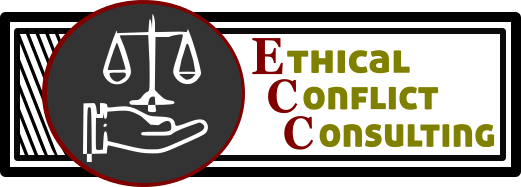Maximize Effective and Professional Communications via Emailing
By William Brant, PhD.
Contents
I. Introduction
II. When it is best to use emails and other forms of communications
III. When to use the telephone for professional communications
IV. Using instant messages and texts
V. Structures of emails
VI. Consider some changes in the content of your messages
VII. Styles of Communication
VIII. Professional email templates for situations in professions: Establishing Work-Life Boundaries and Responding to False Accusations Conclusion
VIII.i Refusing to Work Extra Hours Beyond Your Employment Contract’s Descriptions
VIII.ii Turning Down a Colleague’s Unwanted Invitation
Conclusion
I. Introduction
Understanding and using emails, especially at the office, has become ever more important. There are now companies and software that large organizations use to judge what level their employees’ engagement at work is. Scores based on emails show that workers feel positive or happy and are engaged at work, or they signify tension, disappointment, stress, and irritation. For example, the software called Vibe (https://vibe.en-japan.io/) offers to analyze and monitor teams’ morale in real-time.
The emails sent through companies’ systems have already replaced the need for certain types of surveys. Emails are playing leading roles in the presentations of information to select groups of people. Videos, images, audio, text and multi-media files are regularly sent from workers.
Potential violations of corporate rules can be identified via software. The emails you send may appear to be private for two or just a few people. However, they are recorded and archived. Privacy rights of individuals and of organizations are concerns. An individual’s past emails can be easily spotted, analyzed and used for dismissal. This should convince us that there is no better time to begin focusing on writing emails with the utmost professionalism.
II. When it is best to use emails and other forms of communications
There are numerous reasons why sending an email as a communication tool is not a good idea. You should know when you should be sending emails as opposed to offering other people different technologies for written, spoken and face-to-face communications.
To develop your professional communication skills, you want to use more forms of communication as relationships with your supervisors, colleagues, subordinates, clients etc. become closer.
Emails often serve to replace phone calls. Emails bring gaps of time with them. So, phone calls are often superior when finding a common ground, reaching an agreement and an end. Phone calls are generally superior to emails when emotions need to be expressed, when you want to test the borders or limitations, and when handling delicate situations.
Emails are so easy to send that they tend to involve unnecessary exchanges. Oftentimes, short messages and questions either do not need to be answered or another way can be used to find answers. Consider sending emails less frequently if you are sending many to the same colleague. Each email is interruptive. Consider how much the person should be interrupted.
When you send a message to someone the first time, do not assume that the receiver is familiar with your email. When you receive emails make sure that you are using filters so that some emails are sent to your spam folder. Check your settings on your spam folder so that it is not overly restrictive or open access. You will avoid more viruses this way.
Emails provide records of communications. You can therefore be held responsible for what you write. Carefully watch people’s emails who are unprofessional, especially if you suspect they are malicious.
Do not forward other people’s messages without their permission or without at least asking them and giving them ample time to tell you not to send out their messages.
Assume that others will forward your messages to others. This brings risks with it. Remember also that forwarded messages can be edited, cut down, and changed. If your words are important, regarding their content, it is best to attach a Word document or PDF file. (Note: of course, the attachments come with their own disadvantages that need to be considered)
III. When to use the telephone for professional communications
More ideas are able to be expressed in a shorter time via the phone than via email. When you hurry for a response, use the phone instead of emails. Use the phone when you express emotions. Use the phone when you want the receiver’s responses to be immediate or when you want to engage in conversation.
Phone calls can allow you to set the times, dates, locations and lists of items and participants for meetings faster than emails. Phone calls are less likely to be recorded. Emails are automatically recorded. Emails are archived. So, calls are generally more private than emails.
Of course, it is possible that when you speak over the phone, your voice is being projected over a loud speaker. For the purpose of reducing risks, assume that your phone calls are being recorded. So, choose your words wisely, especially during your professional life. (Note: if someone records your voice or sends out your email to others without your permission, it can be best to inform the person via email that you need to be informed and give the person confirmation to do this)
IV. Using instant messages or texts
Instant messages and texts make it easier for small groups to communicate and to share ideas. Instant messages and texts occur in real time (e.g., with social media, like Facebook, WeChat, WhatsApp, Telegram and many others). Texts are usually shortened (e.g., Txts r ez to shrtn (i.e., texts are easy to shorten)). Voice messages offer ways to provide more communicative content and expressions of emotions in just a few seconds.
V. Structures of emails
In addition to attachments, emails are structured so that they may include the following:
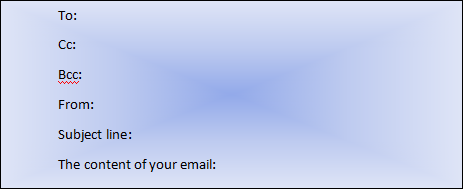
Replying to an email is quite simple because emails are generally structured to fill out the recipient and subject line automatically. Replying to all allows for the Cc to be filled out as well.
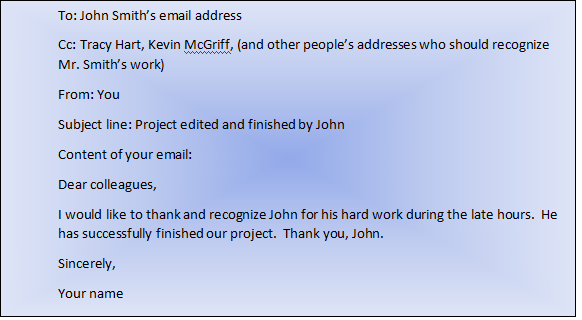
Make sure that you realize the difference between fields, To and Cc. When you are giving credit to one person, John Smith, you should make sure that this person is in the To field and the others are in the Cc. For example, consider the following email.
Email 1 is a good example of how to properly use the To and Cc fields. The To and Cc fields should only be used when it is appropriate for everyone to receive each other’s email addresses. However, it is wise not to share everyone’s email addresses with all the recipients. If you write to many people at once, a group email list is better. It is a good idea to save people’s anonymity by placing all of the people in the Bcc field. Have a look at the next example, email 2.
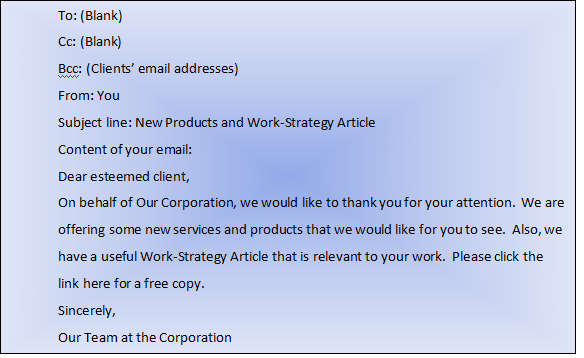
VI. Consider Some Changes in the Content of Your Messages
It is best to write professionally so that you are neither rude nor overly polite. In your professional world, try to write relevant messages. Use another form of communication if you are changing your style of communication.
In two university online courses, students were asked to secretly carry out two sets of tasks. All students were assigned tasks of solving ethical problems in workplaces by writing what should happen in different scenarios. The first secret tasks were for students in secret group 1, which lasted one week.
Instructions: Secret group 1 was encouraged to responded to their peers rudely and to disagree with everyone. The result involved a lot of confusion, and the students were unable to solve the problems in the online class forums. They were generally angry at their rude peers, but they kept their anger a secret. The learning objective was to increase their skills of handling misconduct in the workplace.
Two weeks later and for two weeks in length, secret group 2 had the tasks of responding to their peers with overly polite messages. They were encouraged to write only in agreement with the worst points that the others made. Students were encouraged to write messages that showed a “low intelligence” with misspellings. They also attempted to get the others off of the topic by complementing them on unrelated ideas. They gradually intensified the overly polite messages and the stupidity, and they began misspelling the names of their peers by the end of the second week.
Again, the students who were not part of the secret groups were unable to problem-solve. They drifted away from the topic and began writing things that were irrelevant. They were annoyed by the overly polite messages.
So, what can we learn from this? In the professional work environment, it is very easy to waste time when you are confronted with rude disagreements. It is also easy to waste time when you are surrounded with excessive politeness and excessive agreements with your ideas that are more irrelevant. Your critical thinking skills and problem-solving skills are temporarily lowered during these times of emotional message exchanges.
You should understand that although the students were writing messages of lower level intelligence, the students were intelligent and sophisticated. One problem you might encounter in your workplace involves people who pretend to be less intelligent than they really are. Watch out for these people! Do not trust that their emails represent who they are exactly.
On the other hand, it is a good idea to consider the reasons for rudeness. A colleague or client might be rude in a message because of a hostile environment at home, a headache, stomachache or because he or she is slightly annoyed with you. It is worthwhile to figure out why the person is rude. Keep in mind that people are rude at time. You should challenge yourself to increase your productivity.
What can you do to improve this? Make sure that you are sending professional messages. Check your messages to be sure they are neither rude nor overly polite. Refrain from sending unnecessary messages or use another form of communication to send less important messages, jokes, and so forth.
IV. Styles of Communication
In the world of professions, you will certainly encounter multiple styles of communication. They can each be necessary at times for communicators to satisfy people’s needs. At other times, however, these styles show that the communicator is extremely unprofessional.
The assertive style of communication is especially professional to use when you have an idea, solution or answer that is superior to the others. It may benefit you to write with an aggressive style, especially if you are defending yourself and pointing out some of the consequences. With emails, however, you need to be very cautious with your expressions of aggression. Writing with CAPS can be interpreted as aggressive, especially for certain words (e.g., This is ILLEGAL.).
The passive-aggressive style of communication can be used as an example about what not to write to a person. It is generally better to express emotions and concerns in person. We do not have many examples of the use of passive-aggression for increasing efficiency or professionalism. It may even convey to others that you are a jealous person.
The context is important. If a colleague has done something bad, and it impacted both of you negatively, but the same colleague is praised on that day by your direct supervisor, a passive-aggressive message may likely follow. On one hand, refraining from answering a colleague’s email can be interpreted as passive-aggressive. On the other hand, the passive-aggressive communicator may write: Truly great job today.
It may benefit employers, managers and other employees at times to use the submissive style of communication. It can benefit an employer to communicate submissively by granting employees raises after one employee requests one, especially if business is projected to be successful and the time period between raises is logical. It can benefit employees and managers likewise to communicate submissively to their superiors or inferiors as the recognition of their authority or realizations that the directions of their decisions are professional.
You should also know when you are communicating submissively so that you do not do so frequently. Refraining from communicating submissively can prevent others from taking advantage of you.
The manipulative style of communication involves extracting emotional responses from others and strategically getting people to do things they would not ordinarily do by using deception. The goal-directed transfer of information used for influencing people is a political aspect of communication. Advertisements, sales promotions, public relations, personal sales, and product placements involve the manipulative style of communication but may also involve each of the other styles of communication, too.
The humorous style of communication may involve sending a picture of a political cartoon or a joke. These can lighten the mood, especially if they involve something relevant and you share a similar sense of humor with the person to whom you send it.
VIII. Professional email templates for situations in professions: Establishing Work-Life Boundaries and Responding to False Accusations
In many businesses, it is necessary to assert that you will be unable to attend or to participate in an event or extra work activities that are outside of the hours agreed to by you and your employer. This may involve your supervisor requesting for you to come in on Saturday or to stay late after work. Displaying your borders by being assertive is crucial. You need to know how to say no to your supervisor.
Email 3 involves situations where you need to establish work-life boundaries quickly and firmly. Email 3 is one that you will want to write and send quickly so that your employer knows what to expect and can plan accordingly. Before you augment and improve email 3 and send it to your supervisor/s, make sure that your days, hours and any additional time spelled out in your employment contract are on your side. This email should be sent when you are being asked to go beyond your duties that you agreed to with this organization’s employer.
VIII.i Refusing to Work Extra Hours Beyond Your Employment Contract’s Descriptions
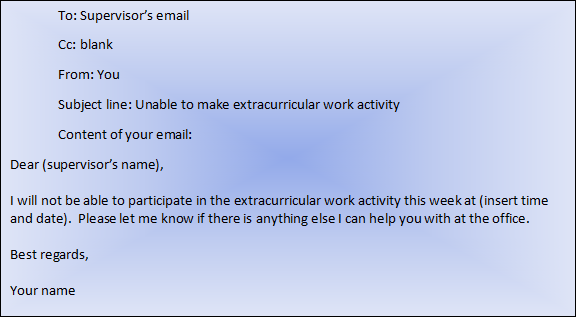
There are three relevant types of responses that managers may send after receiving an email like email 3. First, the manager may ignore it and perhaps even pretend not to have seen it, or she may have forgotten about it. For these reasons, you may find it best to reassert your message in another form of communication.
Secondly, the manager may try to label you as being insubordinate. However, you have your employment contract on your side, and the demand to work extra hours (i.e., beyond your contractual agreement) is a violation of your employment contract. Thirdly, the manager may acquiesce and respect your boundaries. The third response or treatment of you in the future is the purpose of email 3.
You should be aware that the manager may answer differently based on the situation. So, be prepared for the least desirable responses. However, you should also consider the fact that if the manager gives the less desirable responses, then the manager sacrifices his or her professionalism. You may receive that response if you are the only one who refrains from working, for instance.
The need for employees to work extra hours signifies that the organization is poorly prepared or that they have a sudden need for at least another temporary and/or part-time employee. You may also consider negotiating for overtime in such situations. Contact our services at ECC
VIII.ii Turning Down a Colleague’s Unwanted Invitation
In email 4, you have already been asked out by a colleague, and you do not want to go out with him or her. It is important to sustain your work-life balance by displaying your personal boundaries. This typically involves spending your time with friends and family outside of work more than with colleagues.
Email 4 is also ideal to send as soon as possible. This will allow for the inviter to invite others instead. You may include the fourth sentence of email 4 to intensify and clarify your boundaries if you judge the situation and invitation as one that will reoccur in the future.
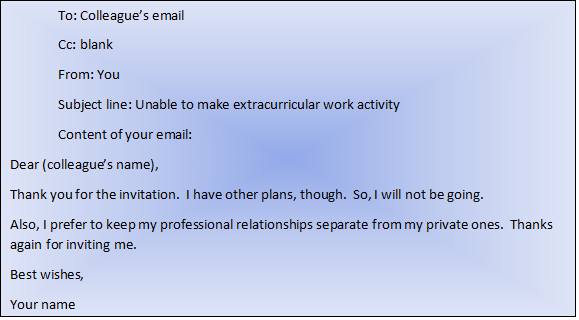
VIII.iii Handling False Accusations
In email 5, you have already been criticized harshly by a supervisor for something that you did not do. For an organization to run professionally, it is important that the responsibility and blameworthiness are attributed fairly and fittingly.
You have a duty to your organization as a professional to maintain a professional work environment. Remember that people, and especially managers, make mistakes sometimes. So, you do not want to respond aggressively.
Email 5 also establishes your boundaries and calls attention to the unprofessional behavior of your supervisor. It does so in a subtle way, though.
While creating unprofessional work environments, managers may send their subordinates messages of harsh criticism, accusing them of something, when they do not believe they did it. This point is important to understand. When managers send harsh criticisms to their subordinates that they disbelieve, it is often a tactic for managers to begin leading authoritatively. Managers sometimes believe that if a subordinate thinks he or she owes the manager, then that employee will be more likely to follow commands.
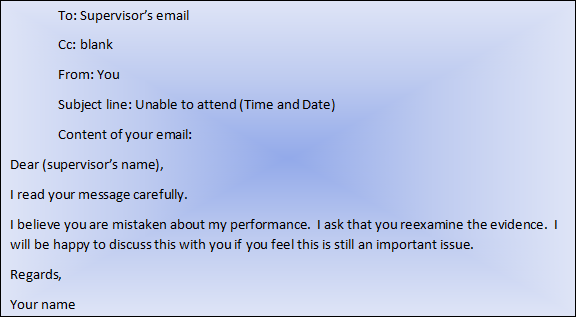
Conclusion
Writing professionally-minded emails is a challenge. So, challenge yourself to refrain from responding to emotionally charged, aggressive and deceptive emails by appearing calm, cool and collected with thoughtfulness. When a colleague or supervisor sends you a message that is unprofessional, remember that this can sometimes serve to benefit you.
Contact our services at Ethical Conflict Consulting for more information and strategies for increasing professionalism, for calling attention to unprofessionalism, and negotiating at the workplace. We are a nonprofit organization that aims to educate you so that you protect your rights as a worker and increase your success regarding your work-life balance.
Citation: Brant, William A. (2021). “Maximize Effective and Professional Communications via Emailing.” Ethical Conflict Consulting. August edition.
